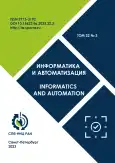Том 22, № 3 (2023)
Artificial intelligence, knowledge and data engineering
Application of Multilevel Models in Classification and Regression Problems
Аннотация
 487-510
487-510


Object Recognition by Components and Relations between Them
Аннотация
 511-540
511-540


A Systematic Study of Artificial Intelligence-Based Methods for Detecting Brain Tumors
Аннотация
The brain is regarded as one of the most effective body-controlling organs. The development of technology has enabled the early and accurate detection of brain tumors, which makes a significant difference in their treatment. The adoption of AI has grown substantially in the arena of neurology. This systematic review compares recent Deep Learning (DL), Machine Learning (ML), and hybrid methods for detecting brain cancers. This article evaluates 36 recent articles on these techniques, considering datasets, methodology, tools used, merits, and limitations. The articles contain comprehensible graphs and tables. The detection of brain tumors relies heavily on ML techniques such as Support Vector Machines (SVM) and Fuzzy C-Means (FCM). Recurrent Convolutional Neural Networks (RCNN), DenseNet, Convolutional Neural Networks (CNN), ResNet, and Deep Neural Networks (DNN) are DL techniques used to detect brain tumors more efficiently. DL and ML techniques are merged to develop hybrid techniques. In addition, a summary of the various image processing steps is provided. The systematic review identifies outstanding issues and future goals for DL and ML-based techniques for detecting brain tumors. Through a systematic review, the most effective method for detecting brain tumors can be identified and utilized for improvement.
 541-575
541-575


The Analysis of Ontology-Based Neuro-Symbolic Intelligence Methods for Collaborative Decision Support
Аннотация
 576-615
576-615


Mathematical modeling and applied mathematics
Convergence in Norm of Collective Behavior Dynamics in the Reflexive Model of Oligopoly with Leaders
Аннотация
 616-646
616-646


Minimization of Peak Effect in the Free Motion of Linear Systems with Restricted Control
Аннотация
A peak effect minimization problem in the free motion of linear systems is considered in the paper. The paper proposes an iterative procedure for the peak effect minimization using a combination of the recently proposed gramian-based approach and the theory of using the condition number of an eigenvectors matrix for the upper bound estimations of the system state processes. Minimization of control costs is based on the analysis of the singular value decomposition of a gramian of control costs, followed by the formation of major and minor estimations of the gramian. Minimization of peak effect in the trajectories of free movement of systems is carried out by minimizing the condition number of the eigenvectors matrix of the matrix of a stable closed-loop system, while the state matrix with the desired eigenvalues and eigenvectors is designed with the generalized modal control. The development of an iterative algorithm for the peak effect minimization in the trajectories of linear systems under any non-zero initial conditions with restricted control is based on an aggregated index. The index takes into account both the estimate of the gramian of control costs and the condition number of the eigenvectors matrix of the stable closed-loop system. Minimization of the aggregated index makes it possible to ensure minimal deviations in the trajectories of free movement of systems of the considered class. The procedure is applied to a system of two satellites with restricted control, where peak effects in satellites relative trajectories are minimized. Two cases of peak affect minimization are considered. In the first case, the peak effect minimization in the trajectories of free movement of satellites is carried out only by minimizing the gramian of control costs. In the second case, the peak effect minimization is realized using the developed algorithm. The results illustrate the efficiency of the procedure and indicate the decrease of the peak effect for the satellites relative trajectories.
 647-666
647-666


Designing of 2d-IIR Filter Using a Fused ESMA-Pelican Optimization Algorithm (FEPOA)
Аннотация
Many Digital Signal Processing (DSP) applications and electronic gadgets today require digital filtering. Different optimization algorithms have been used to obtain fast and improved results. Several researchers have used Enhanced Slime Mould Algorithm for designing the 2D IIR filter. However, it is observed that the Enhanced Slime Mould Algorithm did not achieve a better solution structure and had a slower convergence rate. In order to overcome the issue a fused ESMA-pelican Optimization Algorithm (FEPOA) is utilized for designing the 2D IIR filter which incorporates the pelican Optimization Algorithm with the Enhanced slime Mould Algorithm (ESMA). At first, the Chaotic Approach is utilized to initialize the population which provides the high-quality population with excellent population diversity, after that the position of population members is to identify and correct the individual in the boundary search region. After that, by the pelican Tactical Approach is to examine the search space and exploration power of the FEPOA, then the Fitness is calculated randomly, and the best solution will be upgraded and then moved towards the iterations. It repeats the FEPOA phases until the execution completes. Then the best solution gives the optimal solution, which enhances the speed of convergence, convergence accuracy and the performances of FEPOA. The FEPOA is then implemented in the IIR filter to improve the overall filter design. The results provided by FEPOA accomplish the necessary fitness and best solution for 200 iterations, and the amplitude response will achieve the maximum value for =2,4,8 as well as the execution time of 3.0158s, which is much quicker than the other Genetic Algorithms often used for 2D IIR filters.
 667-690
667-690


A Model for Assessing the Functional Stability of Information Infrastructure Elements for Conditions of Exposure to Multiple Computer Attacks
Аннотация
 691-715
691-715











